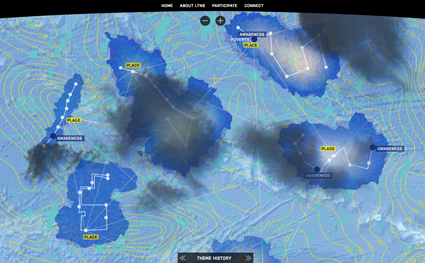Transformational walking
Anne Phillips, Long Time, No See?

Keith Armstrong and collaborators, Long Time, No See?
The Long Time, No See? workshop, or “walkshop” as it was described in the brochure, came at the tail end of the packed ISEA2013 program, by which time my energy levels were seriously beginning to lag.
However, the promise of participating in a collective imagining of the future through a Smartphone App which documents each participant’s journey and then generates an online artwork complete with algorithmic soundscape was more than enough to motivate me to make the trip to Parramatta. I just wasn’t sure if it was enough to keep me awake throughout the day. This was something I need not have worried about.
Setting your compass
Our foray into Long Time, No See? began not with the App but with a brown paper bag containing instructions and workbooks. I was tempted to say something smart about whether we had to burn them afterwards, but I managed to restrain myself. To be honest, after a week of incessantly wielding iPhone and laptop I was enjoying handling the crisp paper booklets.
It seems that Long Time, No See? is much more than an App or a website. It’s about alternative ways of imagining the world. Writer and workshop facilitator Linda Carroli describes it as “a type of hopeful adventure” which endeavours to “make the invisible visible.” Carroli paced back and forth as she spoke, gently urging us into thoughtful interrogations of about how we, as individuals and communities, construct the future.
Her narrative was subtle, abstract and oddly compelling. I began to suspect that the simplicity of the language concealed the project’s deep intellectual underpinnings. The Creative Director of Long Time, No See?, I felt that Keith Armstrong, silently observing our progress, should have been holding up a sign saying “Warning: Deep Waters Ahead.”
We spent the morning working through the group activities outlined in the “Setting your Compass” booklet, which prompted us to reflect on keywords such as “intent,” “care” and “change” in a number of contexts, before being led outdoors, Apps in hand, by Carroli’s quiet, challenging narrative.
Field testing
In the centre of a grassy expanse in a nearby park, each of us marked the spot where we intended to start. The first of nine stages outlined by the App directed us to take one step forward and two steps back and so on until we’d taken nine steps, but ended up being three steps behind the place from where we intended to start.
Embarking on a journey which didn’t seem to progress very far was amusingly metaphorical. The process also made me more aware of my surroundings, because I’m inclined to march from place to place as if I were a contestant in a plain-clothes orienteering competition. While it initially took quite a while to travel a very short distance, in the following stages, we were free to cover as much or as little ground as we wished.
At each stage the App prompted us to select keywords or tags and directed us to observe or interact with our surroundings by making notes, photographs or sound recordings. I had some trouble with the App’s sound recorder, but designer Robert Henderson and software developer Petros Nyfantis quickly ironed out the glitches and I was soon immersed in the contemplative process of walking, observing and reflecting.
Future mapping
Completing the walk felt like an achievement in itself, but seeing the data we had generated uploaded onto community.long-time-no-see.org provided a whole new world to explore. Our walks appeared to hover in space as ‘islands,’ consisting of waypoints or nodes in the form of photographs or tags joined together by lines.
The islands in Long Time, No See? are plotted in relation to ideas, so that someone’s walk in Brisbane can appear in close proximity to one in Parramatta if they have used similar tags or ideas. The background, which consists of layers of geological, climatic and urbanisation data, is accompanied by a spectacular generative soundscape created by composer Roger Dean, which reconfigures itself via an algorithm depending on the proximity of ideas to each other.
Even though it was late in the day, seeing Long Time, No See? in action proved to be a complex sensory experience—highly sculptural and extremely thought provoking. We found ourselves eagerly discussing how our individual explorations fitted in to the broader picture described on the map and identifying where our thoughts coincided with those of others.
Now that we have our login details, we can create new walks or review old ones through the App or access the web-based visualisation on our desktops, providing there’s a high-speed internet connection.
At this stage, there is a limit to the number of walks which can be depicted on Long Time, No See? at one time, so your walks won’t stay on the website indefinitely. However, the Long Time, No See? team seem to be brimming with ideas and so we can expect much from this project in the future.






